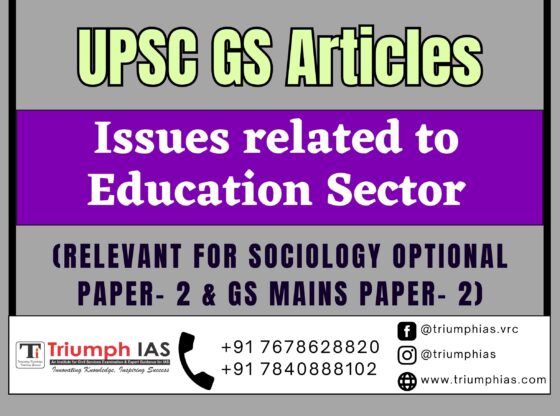Issues related to Education Sector
Relevant for sociology optional Paper- 2 & GS Mains Paper- 2

The education sector is one of the most important pillars of any society, as it provides the foundation for the development and progress of individuals and nations. However, despite its vital role, the education sector is plagued by numerous issues that hinder its effectiveness and efficiency. In this essay, we will explore some of the key issues related to the education sector in India and their impact on the country’s socio-economic development.
One of the major issues faced by the education sector in India is the problem of access. Despite the government’s efforts to promote education for all, there are still millions of children who do not have access to education. According to a UNESCO report, there were 8.4 million out-of-school children in India in 2019, which is the highest number in the world. This problem is particularly acute in rural areas, where the lack of infrastructure, poverty, and cultural norms often prevent children, especially girls, from attending school. Moreover, even those who do attend school face the problem of inadequate infrastructure, such as a lack of classrooms, toilets, and clean drinking water.
Another issue related to education in India is the quality of education. Despite the country’s rapid economic growth and the increasing emphasis on education, the quality of education remains a major concern. According to the Annual Status of Education Report (ASER), which is based on a nationwide survey of rural schools, a significant percentage of students in India lack basic reading, writing, and arithmetic skills. This is partly due to the lack of trained teachers, especially in rural areas, where many teachers are untrained or have inadequate training. Additionally, the curriculum is often outdated and does not adequately prepare students for the demands of the modern job market.
The issue of gender disparity is also a major concern in the Indian education sector. Although the government has made efforts to promote gender equality in education, the reality is that girls still face significant barriers to accessing education. This is especially true in rural areas, where girls are often expected to help with household chores and are seen as a burden on the family. Moreover, the lack of female teachers and inadequate infrastructure, such as separate toilets and safe transportation, make it difficult for girls to attend school. As a result, many girls drop out of school early, which limits their future opportunities and perpetuates the cycle of poverty.
Another issue related to education in India is the digital divide. The COVID-19 pandemic has highlighted the importance of digital infrastructure in education, but India still lags behind in this regard. According to a report by the National Sample Survey Organisation (NSSO), only 15% of rural households have access to the internet, compared to 42% of urban households. This digital divide has widened the gap between urban and rural students, as urban students have access to online resources and digital learning tools, while rural students often do not. This has further compounded the problem of access and quality in education, as students in rural areas are at a disadvantage compared to their urban counterparts.
Another issue related to education in India is the problem of commercialization. Many private schools and colleges charge exorbitant fees, which puts quality education out of reach for many students from lower-income families. Moreover, some of these institutions engage in unethical practices, such as accepting donations in exchange for admission or grades, which undermines the integrity of the education system. This has created a two-tier system of education, where only those who can afford quality education are able to access it, while the rest are left with substandard education.
The issue of vocational education is also a concern in India. Despite the country’s rapidly growing economy, there is a mismatch between the skills demanded by the job market and those provided by the education system. Many students graduate from school without the skills needed to secure gainful employment, which leads to underemployment or unemployment.
To address this issue, the government has launched various initiatives to promote vocational education and skill development. The Skill India Mission, launched in 2015, aims to provide vocational training to millions of youth and increase their employability. The National Skill Development Corporation (NSDC), a public-private partnership, has also been established to coordinate and implement skill development programs across the country. However, there is still a long way to go in terms of bridging the skills gap and ensuring that students are equipped with the skills needed to succeed in the job market.
In conclusion, the education sector in India is beset by numerous issues that hinder its effectiveness and efficiency. The problems of access, quality, gender disparity, digital divide, commercialization, and vocational education must be addressed through a coordinated and sustained effort by the government, private sector, and civil society. Only then can India’s education system fulfill its potential to drive the country’s socio-economic development and provide a better future for its citizens.
For more such free UPSC notes, Articles, News & Views Join our Telegram Channel. https://t.me/triumphias
Click the link below to see the details about the UPSC – Civils courses offered by Triumph IAS. https://triumphias.com/pages-all-courses.php


